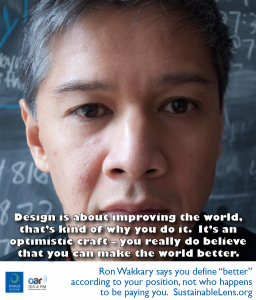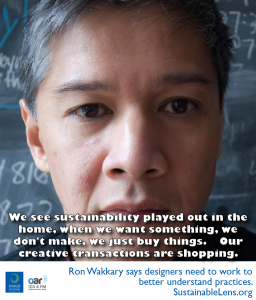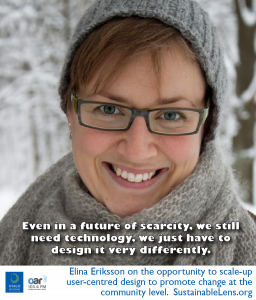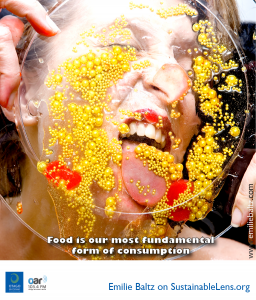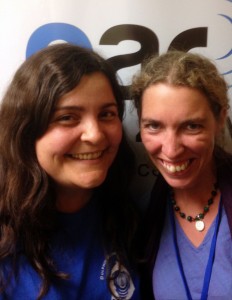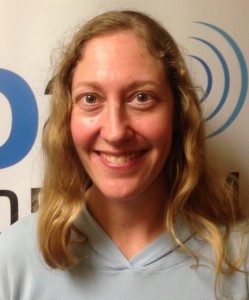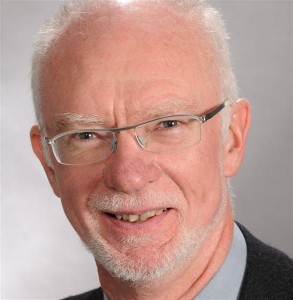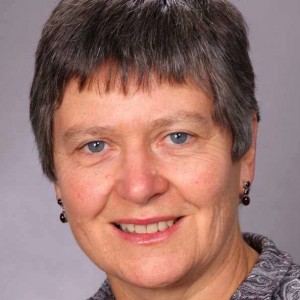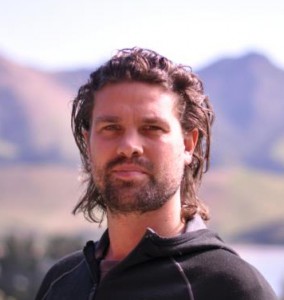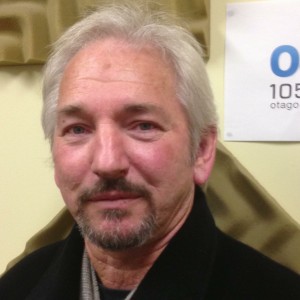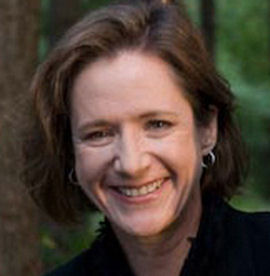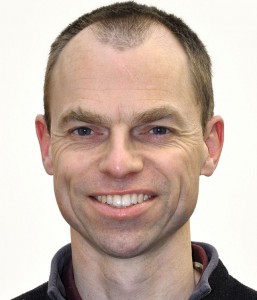Design is about improving the world, that’s kind of why you do it. It’s an optimistic craft – you really do believe that you can make the world better. The position you have determines your view on what better is – not who happens to be paying you.
Dr Ron Wakkary is Professor in the School of Interactive Arts & Technology at Simon Fraser University in British Columbia, he is Editor-in-Chief of ACM Interactions and Director, Interaction Design Research Centre.
Talking points
I was a painter…I was interested in collaboration, I became interested in computing for colloborations with other artists, and conceptual art – performances.
Then I began a small digital design firm
The practices became blurred because digital media blurred the lines – you didn’t have to say if it was a painting, photo or performance. But digital collaboration was key.
I did my PhD so research could be a platform for my art.
I just marvelled that you could ask questions, critical questions, really interesting engaging questions, and find people who could be also interested in these questions…and find the funding to explore them.
Research and teaching all blends together for me, it’s all really a platform for enquiry.
Making and how we make things is really fundamental to how we construct our lives. Sustainability is an example of that….I’m really interested in how people address sustainability through making things.
This goes to the core of what I’m interested in – understanding design and interaction design, how people make things of all practices to affect the lives they lead and that affects sustainability.
Making things is a code for practices. Everyday design – everyone is a designer.
Such as how a family uses multiple resources to create family memories (heights marked on doorframes, photos on fridge etc).
Everyday design practices as sustainable practices… in the sense that people had enduring and resourceful relationships with artifacts.
A resource could be changed and reshaped, it was a resourcefulness that is creative but also sustainable. In contrast to that is how we design technologies, it really negates that. It doesn’t allow us to have enduring relationships with our artifacts. It doesn’t allow us to manipulate them, to change them, it doesn’t allow us to combine them with other simple artifacts. Aside from the obvious (everyday design)…of extending the life of something, it allows people to have much more control over their environment.
Sustainability is such a big issue, but we can see it played out in the home, when we want something we don’t make, we just buy things. Our creative transactions are shopping. And designers are complicit in that.
A user interface is a promise of what functionality or what the potential of this can be, and we tend to want to create this multi-functionality – more and more promise – and those promises, more than not, become broken. But there’s another promise underneath that, that if we didn’t get it right this time, we’ll get it right next time. And this is the desirable thing. Design plays a role in the desire part, in that it creates the promise, breaks the promise, then has permission to got at it again. But this is a problem, in everyday design people don’t look to something for its promise, they look to it for its creative potential.
People could do that with simple things and simple systems…people look for the creative potential, how they readily reuse it, remake it, to be the active agent…this is different from going to buy something based on a promise, then the transaction is all about the purchase and using it to the promise – that’s a very different relationship.
Steampunk is a design fiction – it allows an exploration of a different set of values, a cultural critique, all based on a practice of making. What can professional design learn from that?
In Green DIY, it’s not enough just to be individually sustainable, but to promote sustainability and ways to be sustainable – learning and sharing and being social.
There are countless examples of professional designers getting it wrong an a practice, say going into a community garden and saying ‘if you put sensors and you had this large public display in your community garden, and we did this modelling…’, that doesn’t embed itself into the practice of community gardening.
For me the key is to understand practices, and to be reflexive, and that might mean changing practices.
There’s a set of assumptions we use to get through the day, through our professional lives. There’s a set of assumptions around the power and utility of technology. That’s been incredibly useful, but needs a critical reflection.
We have to find the point where automation is balanced by human agency and interaction. Easy to say…but a very hard balance to find. We don’t really know how to find that balance – so we need to continually reflect on our own practices.
We need to understand people’s existing values, manifest in the things already around them, and try to extend them.
(Would you work for a cigarette company?) No. (Do your students know that?) Yes. Important question.
As a designer you have to have a position. Doing “objective research”, natural science research, is not a particularly effective way of doing design research, you can’t take the researcher out of the research, you can’t take the designer out of the design. You’re simply not a medium to take on the request of your client, you have a position. When you have to make a decision, the only things that are going to help are your experience and your position, and hopefully those two go together.
Removing the designer from the design is really problematic. Inserting the “cool designer, they know aesthetics”, that’s just one aspect, that is also problematic. A good design has coherency and has purpose. It makes an argument and executes it.
A position is not fixed, it can be dynamic.
It has helped me to accept that there are so many ways of doing practice, so each of us should consider how does sustainability affect your practice? And treat that reflexively, and be prepared to change. You can change the means and achieve the same ends.
The desire to be a designer, it is a detailed craft. You have to have a level of commitment and desire. We haven’t created the curriculum to enable it.
We worked with the city of Vancouver in a City Studio, using the city project on their ambitious Greenest City 2020 Action Plan.
We used speculative design strategies: ludic design, critical design, design fiction, value sensitive design – those methods all require the designer to take a position.
Organisations…need to constantly rethink what kind of social grouping they are – what they believe in.
This generation of students, at least the ones I work with, have…a level of everyday activism, there is for many a kind of different calculus that they go through in terms of finding the place that they want to work, who they want to collaborate with, and the communities that they want to be in. That’s not true of everybody, but it doesn’t have to be true of everybody, you need 20% of the people to be like that, and I think there’s way more than 20% of graduates who are doing that.
It’s getting harder to guide students because the kinds of things they are looking for are all over the place…
start-ups, large companies not for profits, social enterprise, so the level of networking that we (academics) have to do do is much more complicated and more involved – it’s great if you can bring it all back into your teaching and research, that works as a really nice virtuous cycle.
There is a need to rethink.
Maybe I’ve naive, but I’m optimistic, and that partly because of what I see in my students.
Sustainability won’t go away. This cuts both ways “are you still talking about that?” and “if we don’t solve it are we really going to fall apart?”. But there’s a persistence there – you can’t get away from it.
The values… I see starting to rise to the top are these really compelling hard things to deal with, so complex, that it’s not always about coming up with a single solution.
Maybe I’m so process oriented, but my practice view…when people have figured out a method that always comes up with an answer, the relevance of the answer is less and less relevant. We have the perfect, air tight totally irrelevant solutions. There’s been a leaning of the ship to the more complex “I’m not going to get an easy answer”.
Experimental method doesn’t lend itself to wicked problems. We’re seeing much more divergence.
(on enjoying his career) There’s enough stuff to inquire about, there are enough problems to keep you motivated, there’s enough good people to around to keep you motivated, there are enough surprises to let you know you don’t have the answers and you have to keep searching, and enough dynamism and change to be optimistic.
Students keep you on your toes more than you keep them on their toes.
(Activist). I’m concerned, I want to find ways I feel like I can contribute.
(Challenges) Increasing complexity and dynamics – finding people who want to work on understanding that.
(Advice) Keep going. Keep making. Chances are, whatever you are doing is not as good as you think, but it’s nowhere near as dangerous or harmful as you think it is. The worst thing is not to do anything – we can rationalise inaction. No-one has the monopoly on what the answer is so it is going to require a lot of divergence and a lot of multiplicity of viewpoints so everyone should be active.
